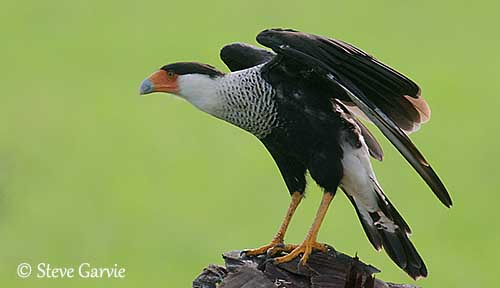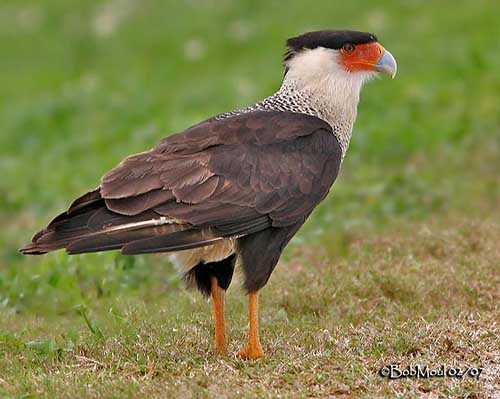
Northern Crested Caracara
Caracara cheriway
Falconiforme Order – Falconidae Family
BIOMETRICS:
Length: 49-58 cm ; Wingspan: 120 cm ; Weight: 1050-1300 gr
LONGEVITY: up to 9 years
DESCRIPTION:
Northern Crested Caracara has a thick, blue grey and strongly hocked bill, with red cere. A patch of bare skin around the eyes can change in colour in few seconds, from pink or red-orange, to yellow when it is excited.
It has long, orange yellow legs, with thin, blunt and flat talons, allowing it to walk, run or scratch the ground for food.
Both sexes are similar, with female slightly larger than male.
Immature are browner than adults, with brown back, buff neck and throat, and whitish buffy breast streaked with brown.
Northern Crested Caracara is the national emblem of Mexico, and named “Mexican eagle”.
VOICE: SOUNDS BY XENO-CANTO
Northern Crested Caracara’s voice is a harsh, rasping call “trak-trak-trak”. Sometimes, we can hear a shriek.
During courtship display, Crested Caracara perches on an exposed perch, and utters a “quick-quick-quick-quick-querr”, first quickly uttered, and last drawn out.
HABITAT:
Northern Crested Caracara prefers dry open areas, with scarce vegetation and some trees, like pastures, savannahs and river edges. It can be found sometimes in forests and marshes.
RANGE:
Northern Crested Caracara lives in south-western United States (Arizona and Texas), and Florida, Central and South America.
BEHAVIOUR:
Northern Crested Caracara is an opportunist feeder, eating some variety of food. It may wade in shallow water, searching for food, under leaves or vegetation. It may also practise piracy, which is for it a common feeding tactic. It is known to harass birds as large as Red-tailed Hawks or vultures, causing them to disgorge food.
Northern Crested Caracara begins to hunt in the early morning, before vultures. It spends much time on the ground with its long legs, walking placidly in open lands. This bird exploits varied food resources in its large territory. It may scratch on the ground to uncover insects; it may take preys walking or running on the ground, and carrying food in the bill or the feet. It tears strips of flesh and lays them aside, and then, it gather them with the beak to carry them.
It is a diurnal bird.
FLIGHT:
Northern Crested Caracara has direct flight with noisy wing beats, but it rarely soars. Its wings beats are strong and steady, but it is not made for fast flights. Crested Caracara is a strong flier, flying with deep wing beats alternated with glides, often low above the ground, twisting and turning as Harriers.
REPRODUCTION:
Northern Crested Caracara pair nests alone. Nest is situated in a solitary tree, rounded with short vegetation or shrubs. It may be located on the ground in pampas, and sometimes in islands in marshes, or under rocks in deserts.
Nest is a structure made with woven sticks, cup-shaped, reaching one metre in diameter, and 40 cm in height. Every year, they add more materials. It is or not, lined with feathers, grass, wool and fine materials, but also with trash (bones and pieces of dried skin) and a mass of pellets ejected by parents.
Female lays 2 to 3 brown eggs, from November to February. Incubation lasts about 28 to 32 days, shared by both parents. Young remain at nest for 8 to 12 weeks, and family members remain together for 3 months after fledging.
This species produces one clutch per season, sometimes two.
Fr: Caracara du nord
All : Schopfkarakara
Esp : Carancho Norteño
Ital : Caracara crestato
Russe : Каракара обыкновенная
Photographers:
Roger Ahlman
Pbase Galleries Peru and Ecuador
Steve Garvie
RAINBIRDER Photo galleries
Bob Moul
Nature Photography
Texte de Nicole Bouglouan
Sources:
HANDBOOK OF THE BIRDS OF THE WORLD Vol 2 by Josep del Hoyo-Andrew Elliot-Jordi Sargatal - Lynx Edicions - ISBN: 8487334156
A GUIDE TO THE BIRDS OF MEXICO AND NORTHERN CENTRAL AMERICA by Steve N. G. Howell, Sophie Webb - Oxford University Press - ISBN: 0198540124
All About Birds (Cornell Lab of Ornithology)
What Bird-The ultimate Bird Guide (Mitchell Waite)
Arthur Grosset's Birds (Arthur Grosset)
The Hawk Conservancy Trust (Hilary Smith)

This species is now named Northern Crested Caracara.
Northern Crested Caracara has black plumage on body, wings and crown. Adults have dark chestnut crest, while juvenile have darker. Neck and rump are white, and we can see white patches on wing tips, conspicuous in flight. Long tail is white, barred with black and with broad black terminal band. Breast and base of neck extended towards nape and shoulders are white, finely streaked with black. Wings are long and somewhat blunt and ample.
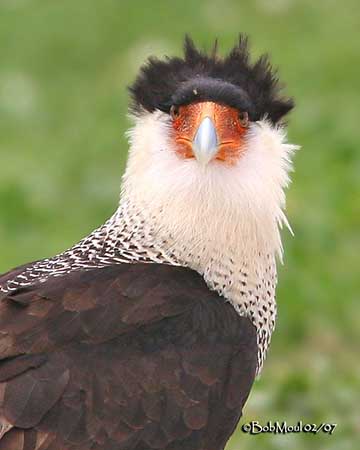
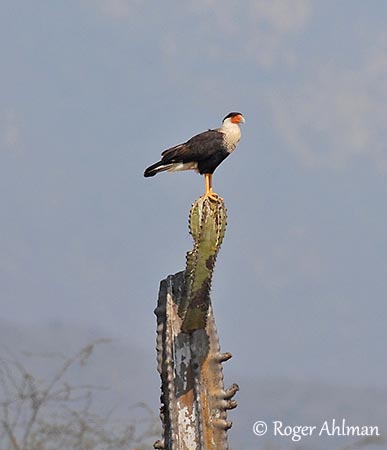
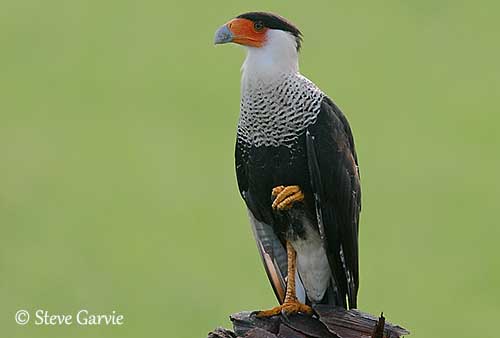
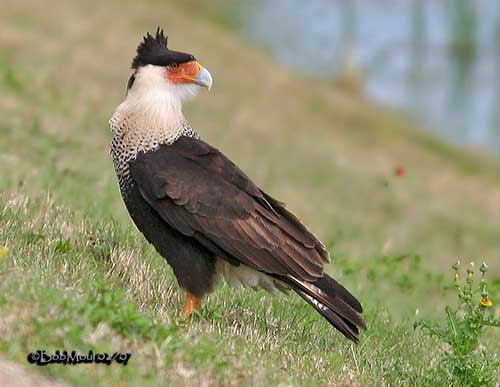
During breeding season, male may fight in the air, with the head thrown back on shoulders and uttering cackling cries. Northern Crested Caracaras are monogamous, and they mate for life. They are very territorial birds, defending nest site where they return from year to year, giving harsh, grating calls, hovering or sitting on it.
Northern Crested Caracara is resident in its range, making some moves according to food resources. Usually solitary, Crested Caracara may be often seen in pair, or in small group of 3 to 4 birds. They gather in flocks to feed, and they may reach numbers of up to 60 individuals.
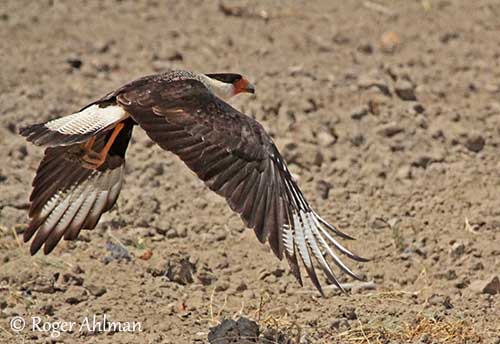
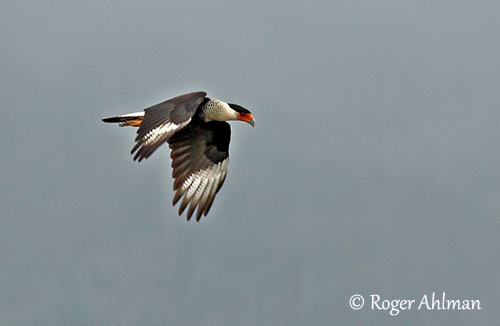
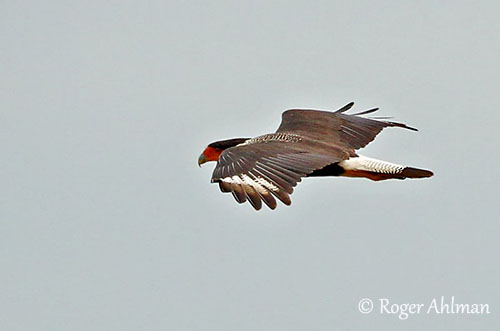
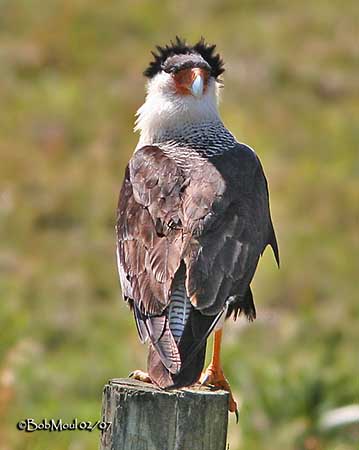
DIET:
Northern Crested Caracara feeds mainly on carrion, but also on insects, invertebrates, fish, reptiles, amphibians, birds, mammals and eggs.
PROTECTION / THREATS / STATUS:
Loss of habitat and hunting had reduced populations of Northern Crested Caracaras.
Species may have extended its range with the extension of agriculture. In Florida, it is classified as threatened by habitat loss to human development, and citrus orchards.
Populations in United States appear stable or slightly increasing after an historical decline.
